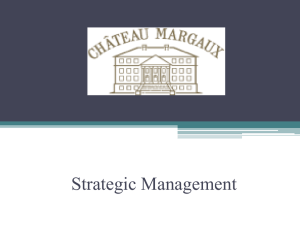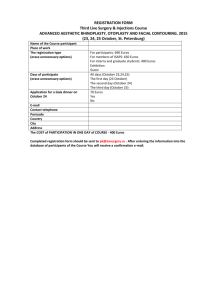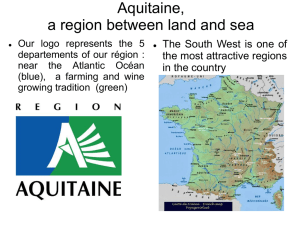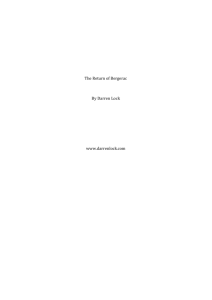File - Bruno, Chief of Police
advertisement
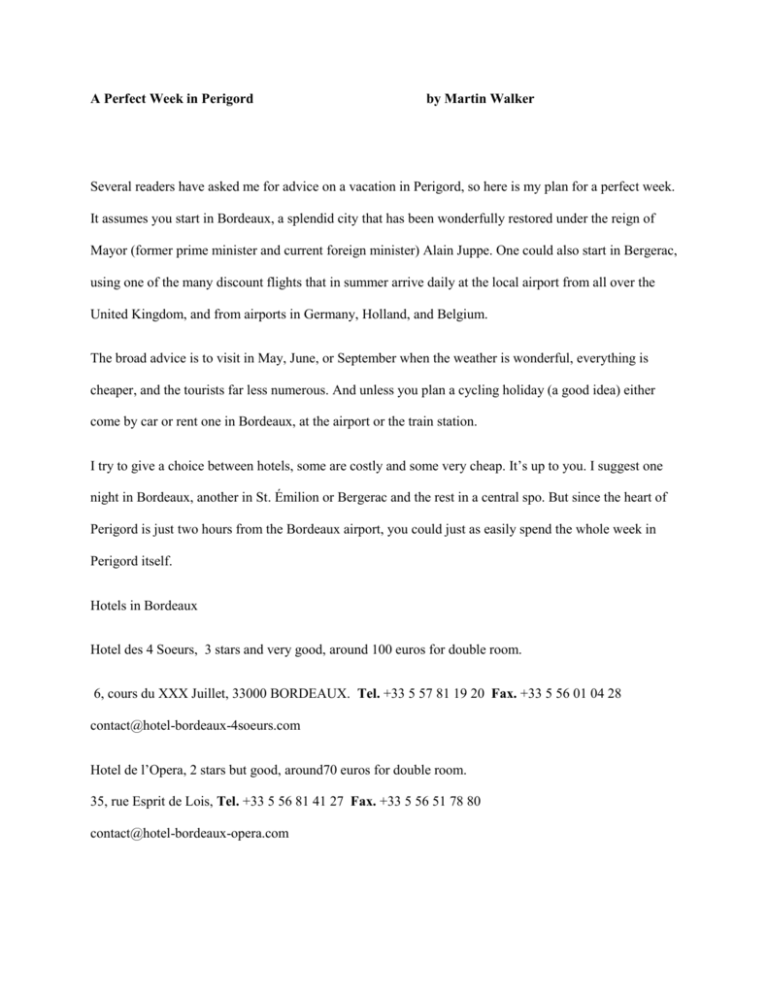
A Perfect Week in Perigord by Martin Walker Several readers have asked me for advice on a vacation in Perigord, so here is my plan for a perfect week. It assumes you start in Bordeaux, a splendid city that has been wonderfully restored under the reign of Mayor (former prime minister and current foreign minister) Alain Juppe. One could also start in Bergerac, using one of the many discount flights that in summer arrive daily at the local airport from all over the United Kingdom, and from airports in Germany, Holland, and Belgium. The broad advice is to visit in May, June, or September when the weather is wonderful, everything is cheaper, and the tourists far less numerous. And unless you plan a cycling holiday (a good idea) either come by car or rent one in Bordeaux, at the airport or the train station. I try to give a choice between hotels, some are costly and some very cheap. It’s up to you. I suggest one night in Bordeaux, another in St. Émilion or Bergerac and the rest in a central spo. But since the heart of Perigord is just two hours from the Bordeaux airport, you could just as easily spend the whole week in Perigord itself. Hotels in Bordeaux Hotel des 4 Soeurs, 3 stars and very good, around 100 euros for double room. 6, cours du XXX Juillet, 33000 BORDEAUX. Tel. +33 5 57 81 19 20 Fax. +33 5 56 01 04 28 contact@hotel-bordeaux-4soeurs.com Hotel de l’Opera, 2 stars but good, around70 euros for double room. 35, rue Esprit de Lois, Tel. +33 5 56 81 41 27 Fax. +33 5 56 51 78 80 contact@hotel-bordeaux-opera.com In Bordeaux treat yourself to a meal at la Tupina, by the Porte de la Monnaie, for some of the finest pork you’ll ever eat, from the cul noir breed. http://www.latupina.com/ St. Émilion I recommend the Logis des Remparts hotel, around100 euros per night for 2 in double room.http://www.logisdesremparts.com/ In Bergerac, the Hotel de France is around 90 euros for a double room with breakfast. http://www.hoteldefrance-bergerac.com/pages/tarif.php For the rest of the stay, or for the whole week: I recommend the less expensive Auberge Medievale in the tiny but pretty village of Audrix, about 5km from Le Bugue, where in May, June, and September bed and breakfast for two in a truly medieval inn costs only 40 euros a night. On Saturday nights in summer, Audrix hosts one of the best nighttime markets in the village square, where the bread is cooked in a giant communal oven in the shadow of an 12th century church.. Buy your lamb and steaks and cheese and foie gras and wine from the stalls and eat at the massed ranks of tables and benches provided. There is often music and dancing. http://www.auberge-medievale.fr/aubergeanglais.htm The Domaine de la Vitrolle just outside Limeuil on the road to Le Bugue is a charming small chateau, used as a secret Resistance HQ by Andre Malraux in the summer of 1944. It has rooms in the chateau for 110 euros a night for a suite, 85 euros for a room, all decorated in 19th century style with some fine antiques. It has over 20 self-contained gites in the grounds, 760 euros per week for a two bedroom flat with sitting room and kitchen, plus a delightful annex with four rooms and its own chapel. Set amid orchards and vineyards and overlooking the river, it has figured in several Bruno novels, inspiring the Domaine in ‘Dark Vineyard’ and the scene of the summit in ‘The Crowded Grave.’ For a vin de table, it now produces remarkably good Merlot and Semillon thanks to a gifted winemaker, John Alexander. www.la-vitrolle.fr For the mid-price budget, try the Hotel du Château in Campagne, between Le Bugue and Les Eyzies, where a double room with breakfast is 120 euros. http://www.hotelcampagne24.fr/hebergement_demi_pension.htm For those wishing to splurge, the Vieux Logis in Trémolat is wonderful. Dinner, bed and breakfast for two is 360 euros a night, but for that you get one of the finest dinners in the world. The menu du marché changes daily and is extraordinarily good value. Henry Miller stayed here, fell in love with place, and wrote, "I believe that this great peaceful region of France will always be a sacred spot for man and that when the cities have killed off the poets this will be the refuge and the cradle of the poets to come. I repeat, it was most important for me to have seen the Dordogne: it gives me hope for the future of the race, for the future of the earth itself. France may one day exist no more, but the Dordogne will live on just as dreams live on and nourish the souls of men." http://www.vieux-logis.com/uk/index.php Further north, the Château de la Fleunie is a beautiful place to stay. http://chateaux-hotels.voyagesdunet.com/france/aquitaine/dordogne/montignac/chateau-de-lafleunie.hotel Larger groups may want to rent a château. The charming Château de Cardou, for example, about 5km from Lalinde and less than 30 minutes from Bergerac airport, sleeps ten and rents for roughly 3,000 to 5,000 euros a week, depending on the season. http://www.simplychateau.com/chateau-details/view/70-chateau-de-cardou/in-region/12-dordogne/ Château le Treillac in Alles-sur-Dordogne, just outside Le Buisson, sleeps up to seventeen and costs from 3,000 to 5000 euros a week http://www.simplychateau.com/chateau-details/view/84-chateau-le-treillac/in-region/12-dordogne/ For renting gites or chateaus I recommend the wide selection and good (English-speaking) management of: www.simply-perigord.com tel 0553-545431. They are Bruno fans, and can be found beside the Gendarmerie in Le Bugue. The Perfect Week Day One—Bordeaux The main tourist office, where wine tours and tastings are on offer, is at: 12 cours du XXX Juillet, 33080 Bordeaux Cedex Tel 33 (0)5 56 00 66 00. Fax 33 (0)5 56 00 66 01 otb@bordeaux-tourisme.com Bordeaux was built on wine. Today, the regional wine trade is worth 15 billion euros a year and they produce almost 1 billion bottles. In Bordeaux, visit the old wine quarter known as Les Chartrons, where the wine négociants built fine houses and where you will find the History of Wine Museum. Must–see sites in Bordeaux: The main riverfront of the west bank is marvelous, like an urban version of Versailles and a delight to stroll along it. The Place de la Bourse is sublime and don’t miss the monument to the Girondins in the Place des Quinconces. The Porte Cailhau, the fifteenth-century entrance to the city, has a great view from the top. The Museum of Fine Arts, founded in 1801 by Napoleon Bonaparte, is worth a visit if only because of its location in the Palais Rohan (the City Hall of Bordeaux). On Sunday, try the market of Le Marché des Quais in Chartrons, along the quayside. On Friday or Saturday, the market to visit is Le Marché des Capucins, a covered market. Classic sites are: Saint-André Cathedral, consecrated by Pope Urban II in 1096. Eleanor of Aquitaine was married here in 1137 but she would not recognise it. Only a wall of the original Romanesque church remains and even thee Royal Gate was bult after her death, while the rest is mostly from the fourteenth and fifteenth centuries. Tour Pey Berland (1440–1450), a massive, quadrangular tower annexed to the cathedral. Église Sainte-Croix (Church of the Holy Cross). It lies on the site of a seventh-century abbey destroyed by the Saracens. Rebuilt under the Carolingians, it was again destroyed by the Normans in 845 and 864. What you see today was built in the late eleventh to early twelfth centuries. Basilica of Saint Michael, late fourteenth and fifteenth centuries. Saint-Seurin, the oldest church in Bordeaux. It was built in the early sixth century on the site of an early Christian tomb and now has a bit from almost every medieval century: an eleventhcentury portico, a twelfth-century apse, and the thirteenth-century nave has chapels from the eleventh and fourteenth centuries. The ancient crypt has tombs of the Merovingian royal family. Day Two—Wine: St. Émilion, Monbazillac, and Bergerac St. Émilion is a lovely old town, very good for strolling, and with fascinating underground cellars, quarries, and a famous underground church. The tourist office has good advice on visiting local vineyards. The Hostellerie de Plaisance offers excellent food, but is not cheap. I prefer L’Antre deux verres, an excellent wine bar with decent food at the foot of the Tour du Roy. http://www.saint-emilion-tourisme.com/uk/ In Monbazillac, visit the delightful Renaissance château, with a good café for lunch on a terrace overlooking the Dordogne valley and tastings of the lovely sweet white wine. The château also does a decent Pécharmant red. In Bergerac, don’t miss in the heart of the old city, “la Maison des Vins” (the House of Wine). It occupies a splendid piece of seventeenth-century architecture, with the charming Récollets’ cloister named after the Franciscan beggar monks who built a monastery there on the orders of Louis XIII. Pick up a map of the vineyards, with details on times of opening etc., called the Route des Vins. Vineyard visits and wine tastings: I recommend Château de Tiregand (Bruno’s favourite Pécharmant red), Château Belingard, and Château de la Jaubertie, but do visit the famous cave of Julien de Savignac in Le Bugue. This is one of the world’s great wine stores (and the inspiration for the wine shop in the Bruno novel The Dark Vineyard.) Pierre Desmartis at la Vieille Bergerie just outside Bergerac won three gold medals in a row at the big Paris agricultural show for his splendid dry white called Quercus, only E8.50 a bottle. Chateau Feely near Saussignac makes certified bio-dynamic wines of very high quality, runs some gites and also offers wine courses. Contact: www.feelywines.com Day Three—The Dordogne Valley to Sarlat When showing friends the area, I start in Le Bugue (which has on Tuesday mornings the best market in the region), take the road to Le Buisson (a good market on Friday), and then head upstream. Another way to start is to take the road from Le Bugue to Audrix and then continue to Le Coux et Bigaroque and to Saint-Cyprien (an excellent market on Sundays) and then rejoin the D703, which follows the river. Essential stops are the two great castles of Beynac and Castelnau, from which the English and French glowered at each other during the Hundred Years’ War. Each is worth a visit. Beynac is where they filmed the 1999 version of Joan of Arc and small boys of all ages delight in Castlenau, with its reconstructed medieval siege machines like mangonels and trebuchets and the chance to don some armor and try a sword fight. The wife of the lord of Castelnau thought the place a bit grim, so persuaded him to build the charming Château de Milandes close by. American nightclub artist Josephine Baker bought it in the 1930s and bravely turned it into a Resistance center in World War II and it’s a good place to visit. We then drive on to the magical village of La Roque Gageac (see restaurant section for lunch recommendations) and then to the hilltop medieval town of Domme with its great views. I usually end the tour at the lovely old town of Sarlat where we simply enjoy the charming old town for a few hours. But you can also continue upstream from Souillac to Sousceyrac and Bretenoux, charming villages and a pretty drive. Sarlat is magical, a town whose center was largely built in the sixteenth and seventeenth centuries and has changed little since. They could film another version of The Three Musketeers here without changing anything except for a few modern shop windows. It stayed that way because the local swamps and malaria put the town into a long decline with little new building until DDT tamed the mosquito. Day Four—Prehistory, the Vezere Valley, Lascaux, Les Eyzies The Vezere valley is known to the tourist board as the cradle of mankind, since this is where Homo sapiens, or the Cro-Magnon people, were first found. Les Eyzies is the center, with its excellent modern National Museum of Prehistory and its associated reception center, Le centre d'accueil de la préhistoire, which offers a simple introduction to the times from 10,000 to 100,000 years ago. From Les Eyzies, the drive up the valley to Lascaux is very pretty, and I usually stop for lunch in the village of St. Léon sur Vezere. Le Petit Léon is a restaurant I enjoy, but along the riverbank from the church is a small snack bar for sandwiches and light meals. After visiting Lascaux, drive 10km east to St. Amand-de-Coly and decide for yourself which of these two villages has the better claim to be France’s prettiest. In my view, the river gives St. Leon the advantage. It’s also worth visiting the fascinating nearby prehistoric site of Castel-Merle, where you can try your hand at making flint knives and using a spearthrower. The Lascaux cave must be seen, even if it is only a perfect modern copy. It is indeed, as l’Abbé Breuil suggested, “the Sistine chapel of prehistory,” an unforgettable experience that overwhelms the visitor with a sense of art, of history, and also of something hard to define but powerfully spiritual. You will never again think of cave people as primitive. The artists may have lived 17,000 years ago but they were evidently people who were at least one fundamental way much like us, with aesthetic sensibilities that we can recognize across the centuries. Along with language and humor, the need to produce art seems to be defining human characteristic. My own fascination for Lascaux and the kind of culture that might have produced its art, lies at the heart of my pre-Bruno novel, The Caves of Perigord. Tickets for the tours of the cave (available in several languages) should be booked in the central tourist office in the nearby town of Montignac. Day Five—The Bastides, or caves and more caves The Bastide towns are a splendid example of medieval town planning. Built as new market towns that were also fortresses, they had big squares for the market, defensible walls, and a sturdy church to act as bastion. The English and French each built them during the Hundred Years’ War for defense in depth but also because the markets provided tax revenues that could go to the king rather than to traditional local barons. Monpazier, Beaumont, Eymet, Moliere, and Domme are fine examples and as well as weekly markets, each also holds special events in summer like antique fairs (called brocantes) and book or wine fairs. If like me a visit to Lascaux just stirs your curiosity about the caves and prehistoric art, it’s worth knowing that there are 147 prehistoric sites and 25 painted caves in the Vezdere valley. Here are my recommendations: Cap Blanc, wonderful animal statues emerge from the rock. Grottes du Roq de Cazelle, kids love the statues and tableaus that seek to re-create the way people ued tolive. Font de Gaume, more than two hundred paintings and engravings of mammoth, bison, deer, and horses. La Roque St Christophe, a huge cliff with a long ledge where people lived from 55,000 years ago, and well until the Middle Ages. There is a legend that English troops abandoned some treasure here in the Hundred Years’ War. Rouffignac, a huge cave with its own train to get you inside, and endless engravings of mammoths. Day Six—Cadouin, Trémolat, Sainte Alvere, Limeuil, the river by canoe The best way to enjoy the river is by canoe, although the wooden gabare boats on the Dordogne are fun. Canoe rentals can be found anywhere but I recommend the ones in Les Eyzies, St. Léon sur Vézère, and Canöes Courrèges, just outside Le Bugue on the road to Le Buisson. Even though the current is in your favor don’t try to go too far. Les Eyzies to Courrèges is a good morning’s work, and St. Léon to Les Eyzies is very beautiful but maybe too long for kids unless you take a picnic lunch and stop and swim along the way. There are villages so lovely they take your breath away, and much of the pleasure of the Périgord is to potter (by road) from village to village, from café to café, buying the local bread. I never tire of the sight of Bigaroque from the bridge where the road from Le Bugue to Le Buisson crosses the Dordogne. Instead of turning right to Le Buisson, go straight ahead and it is right there. Cadouin is a charming old village with a magnificent twelfth-century abbey and magical cloisters and in the second half of August holds a medieval festival. Part of the old pilgrim trail to Santiago de Compostella, it was famed in the Middle Ages for its great relic, a piece of the Holy Shroud, which turns out to have been made in the eleventh-century. Trémolat, where the river is wide enough for the French waterskiing championships, has a lovely twelfth-century Romanesque church with great frescoes, built atop the original ninth-century foundation. Claude Chabrol filmed le Boucher in this village. Limeuil, where the Vézère flows into the Dordogne, is a delight, a lovely old town with a château and a park atop the hill and one of the prettiest mairies in France with a fine garden from which to admire the view. Le Chai, beside the river, is one of the world’s great pizza houses serving varieties I never dreamed existed and an amazing running and flying waiter who soars over steps with your order. Try ordering the excellent cider instead of wine. Sainte Alvère is famous as the home of the truffle market (see my third Bruno novel The Black Diamond), held on Monday mornings from December 1 to March 1 every year. But it is also a pretty town with a ruined castle and one of my favorite cafes, just across the road from the truffle market. Truffles can also be bought online. Day Seven—Périgueux and Return to Bordeaux I really like Périgueux, even though its outskirts make you think of American malls and sprawl. Focus instead on the Roman ruins and the amazing Byzantine-style cathedral with its domes and cupolas that make you rub your eyes and wonder if you’ve landed in Istanbul by mistake. It was restored in the nineteenth century by the great architect Abanie, and became the model of the more famous Sacre-Coeur that overlooks Paris from the hill of Montmartre. There are bits of the old church that date from 1074 at the western end, and on either side are the two confessionals that are even older. Some of the oldest parts, including the tomb of Saint Front, were destroyed by the Protestants when they seized control of the city in 1575 during the religious wars. They secretly crept into the city on a market day, disguised as peasants with swords concealed beneath their cloaks, and kept control of the place for six years. The local lord, Henry of Navarre, was a Protestant who finally ended the religious wars by converting to Catholicism as the price of becoming king of France. “Paris is worth a mass,” he famously said, and was crowned at Chartres cathedral in 1594, but in the Perigord they prefer to recall that he also said that with its great food and wine, the region was ‘paradise on earth.” The old center of the city has houses that date back to the twelfth century, like the Maison des Dames de la Foy on the Rue des Fargues, which was the home of the English governor in the fourteenth century and also a Templar headquarters. One can return to Bordeaux by the new autoroute, with a stop in the old wine town of Libourne, and if you are that close then continue on a few kilometers to Pomerol, home of my own favorite wine, Château Pétrus (see the second Bruno novel, The Dark Vineyard). I was only able to afford it once, and was charmed to find, on a pilgrimage to the château, that it is a very modest manor house, although it does boast a fine statue of Saint Peter on the wall. While still paying final homage to Pomerol, I prefer the old road from Bergerac to Bordeaux through the wine country via St. Foy and Castillon, scene of the great battle in 1453 where the French finally ejected the English from the region. The locals are so proud of this achievement they stage triumphant reenactments each summer from mid-July to mid-August. http://www.batailledecastillon.com/ Market Days Monday: St. Alvère, Hautefort (first Monday of month only). Tuesday: Le Bugue, Gourdon, Thenon, Trémolat Wednesday: Sarlat, Bergerac, Montignac, Périgueux, Siorac, Hautefort Thursday: Domme, Lalinde, Monpazier, Terrasson Friday: Le Buisson, La Roque Gageac (June to September), Souillac Saturday: Sarlat, Belvès, Bergerac, Le Bugue, Montignac, Périgueux. Sunday: Sainte-Cyprien My friend Stephane, who makes the Tomme d’Audrix cheese and the garlic-flavoured aillou that feature in the Bruno novels, runs Le P’tit Jean de Mai stall in the markets of Le Bugue, Le Buisson and St Cyprien and has a small shop and fromagerie about 500metres outside Audrix on the road to Le Bugue. If It Rains … Caves and castle tours are good in wet weather, but Le Bugue seems to have cornered the market for rainy days with children. It boasts a surprisingly large Aquarium, with 300 meters of viewing glass and more than 6,000 species in the tanks. It also offers the interesting and engaging Le Bournat, is a re-creation of a French village of the late nineteenth century, with windmill and blacksmith, baker and barrel-maker, church and schoolhouse and traditional fun fair. Locals dress up to play the parts. Just 5km from Le Bugue is the magnificent cave known as the Gouffre du Proumeyssac, a vast cavern where jazz concerts are sometimes held, which inspired the fifth Bruno novel ‘The Devil’s Cave Swimming Most gîtes and hotels have pools and Audrix has a splendid municipal pool. Personally, I like swimming in rivers., The beach at Limeuil may be all pebbles, but the water is lovely and the current strong enough to make swimming against it a real workout. The Pont de Vic, where the road from Le Bugue to le Buisson crosses the river, is great swimming and very safe. Children love the Etangs du Bos, an aquapark with pools and slides and waves and lots of fun. Take the Audrix road from Le Bugue and go beyond Audrix for about 5km and it is signposted on the right. http://www.le-bos.com/fr/presentation.htm Horses For pony-trekking and serious riding lessons, the Ferme Equestre Belle-Oreille in St. Avit-de-Vialard charges 40 euros a half-day, 65 euros a whole day. http://www.belleoreille.com/ For more serious rides, three- and five-day trips around the region with accommodation included, or even longer jaunts around France , the Ferme Equestre La Haute Yerle has a good reputation. http://www.rando-equestre-hauteyerle.com/ The Poney-Club Arc–en-Ciel in Campagne, on the road to Audrix, offers five days of riding lessons for 160 euros. http://www.arcencielponeyclub.be/index.htm Restaurants The region is famous for its food, but the restaurants can become boring with their endless offerings of the local classics that tourists are assumed to crave. One can tire of foie gras, followed by confit or cuisses de canard and tarte aux noix, all slammed into a menu touristique for 12 to 16 euros. So these are all restaurants where one can enjoy these traditional local dishes, as well as other local foods like game and fish. The house wine, sold by the liter or half-liter, is almost always from the Bergerac, and decent enough. Here are my favorites, with suggestions in every price range. I have added links where available, but many of these restaurants are too small (or too local) to advertise on the Web. The best restaurant in the area (my daughter insists I add “the world”) is Le Vieux Logis in Trémolat. It’s where I take my wife on birthdays and their Menu du Marche is the best value I know.. In the main square is an offshoot of the Vieux Logis, rather cheaper and simpler, called Le Bistro en Face. In La Roque-Gageac, I am torn between la Plume d’Oie and La Belle Etoile, but to dine on the Etoile’s terrace is a delight. In Le Bugue, the locals lunch at Oscar’s, the tourists flock to the open-air terrace and the very good pizzas at La Pergola and both find honest French fare at Le Cygne, a pretty hotel beside the fire station. Just outside Le Bugue on the road to Limeuil is Le Parc, at a lovely spot by a small lake, with very good value buffets. I am not a fan of the Vietnamese place called Le Pha, but its location on the river is pretty. There is a charming wine bar, Chai Monique, where the main street, Rue de Paris, runs into the square of the mairie. The croissants at Patisserie Cauet are excellent. In Limeuil, at the top of the hill, is a charming place called Garden Party, with adventurous and food for 25 euros, and on the river bank is a very good Pizza place called Le Chai In Paunat, Chez Julien, just behind the abbey, is run by a veteran of Le Bistro en Face, and offers an ambitious menu in a marvelous setting. In Le Buisson, the Auberge le Roussel is a real find. Reasonably priced, with simple but excellent food (the vegetable and salads grown in the garden behind the inn), it also offers five modestly priced rooms. http://www.dordogne-perigord.com/leroussel/ There is good food, reasonably priced, and the extra pleasure of an enchanting shaded terrace in thshadow of an ancient church at la Vieille Auberge up the hill from Le Bugue in Audrix. I recommend the kidney stew and their soups are so good you’ll be glad they leave the tureen on the table. Between Le Bugue and Les Eyzies is Campagne, home to a good place called Couleurs that even manages to overcome my distaste for food served on slices of slate rather than old-fashioned plates. There’s a charming inn and excellent restaurant, the Auberge Lou Peyrol, in St Marcel du Perigord, on the road between Ste Alvere and Bergerac. Tel 0553-632445. In Montignac, I like dining in the garden at La Roseraie. For the largest number of restaurants to choose from the best towns are Bergerac, Sarlat, and Les Eyzies. Bergerac Le St.-Jacques (Lovely old rooms in 14th century building) La table du Marche (Tapas meets modern bistro meets good Perigord food) L’Imparfait (In heart of old town, great value and low mark-ups on wine. Do not miss the ThaiViet spring rolls with tuna.) Sarlat Le Grand Bleu (almost as good as le Vieux Logis) Le Bistro de l’Octroi (best value) Auberge de Mirandol (a glorious 15th century building) Les Eyzies Hostellerie du Passeur (very central, food somewhat predictable) Le Cro-Magnon (old-fashioned food, old-fashioned ambiance, none the worse for either) Les Glycines (both building and menu have been well and newly modernized) Le Vieux Moulin (very good food in a pretty spot) Le Metairie (an excellent tarte aux oignons) You might have heard of Les Eyzies’ Le Centenaire, which used to be a Michelin-starred wonder but is no longer what it was. The locals all lunch at the restaurant of Laugerie-Basse, nestled into the cliffs. This is plain food, well cooked in simple surroundings, and we all like the cozy, steamed-up atmosphere in winter and the shaded terrace in summer with its great view of the river. Marche Nocturnes In July and August, one can eat almost every night at a marche nocturne. Tables and benches are placed in the town square and stalls are erected to offer varied dishes from sausages, lamb, and steaks to foie gras and snails, pizzas, salads, bowls of strawberries, and wine. Some places offer vast barbecues of pork and lamb and even Indian and Indonesian food and many offer music of varying quality. The popularity of these events may be peaking. Cadouin used to have one of the best, but the locals stopped it because of the noise and the litter. My favorites are Montignac on Monday, Le Bugue on Tuesday, Belves on Wednesday, Sarlat on Thursday, Le Buisson on Friday, and Audrix on Saturday. Be warned: One of my police chums says they can make up the annual quota of drunk driving convictions at these Marche Nocturne events. One glass of wine is okay, two and you are at risk of a hefty fine. -0This is a very brief guide, and I’ve missed out some favorite places to visit: Château de Commarque, Les Eyzies Château de Hautefort, Hautefort Château de Losse, near Montignac Château de Montreal, Issac (near Mussidan) Château de Bourdeilles, Brantôme Château de Fénelon, Sainte-Mondane (between Sarlat and Souillac) Château de Jumilhac, Thiviers Château de Puyguilhem, Villars Maison Forte de Reignac, Tursac near Les Eysies (home of a man known as the billy goat, who took the jus primae noctis, the feudal right to take the virginity of any bride from his lands, so far that in the 1360s he inspired a revolt). Then I’ve left out the lovely gardens: The formal gardens of Marqueyssac, http://www.marqueyssac.com/ Les Jardins de l’Imaginaire at Terrason, http://www.jardins-imaginaire.com/ And the charming garden of Sardy, http://www.jardinsdesardy.fr/ And then there is the wonderful Renaissance Château of Montaigne (restored after a fire in the 19th century) with the original tower of the famous philosopher, who shut himself up there with his 1,500 books to write his Essais. Michel de Montaigne was perhaps the wisest and most civilized Frenchman and greatest essayist who ever lived, and I feel certain that Shakespeare wrote ‘The Tempest’ after reading Montaigne. Sadly, the Bordeaux wine from the vineyard is rather ordinary. http://www.chateaumontaigne.com/?lang=en This guide—and your visit—could be ten times as long, which makes for an excellent excuse to come back. More information can be found on my website Brunochiefofpolice.com Ends

